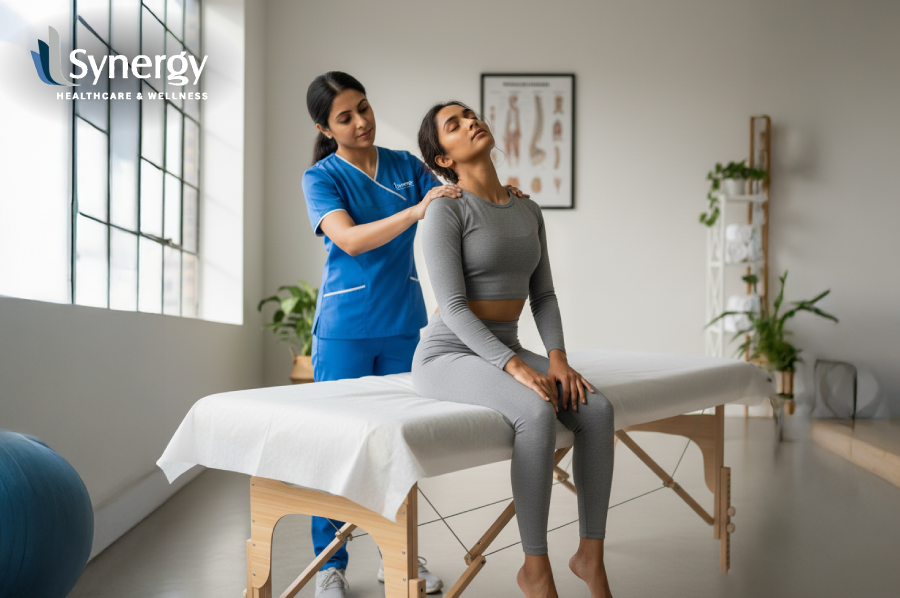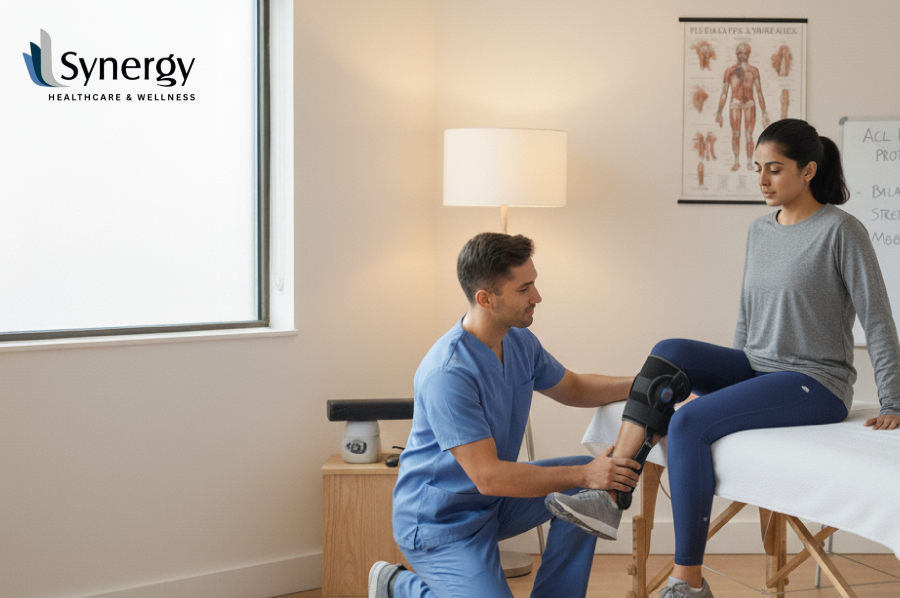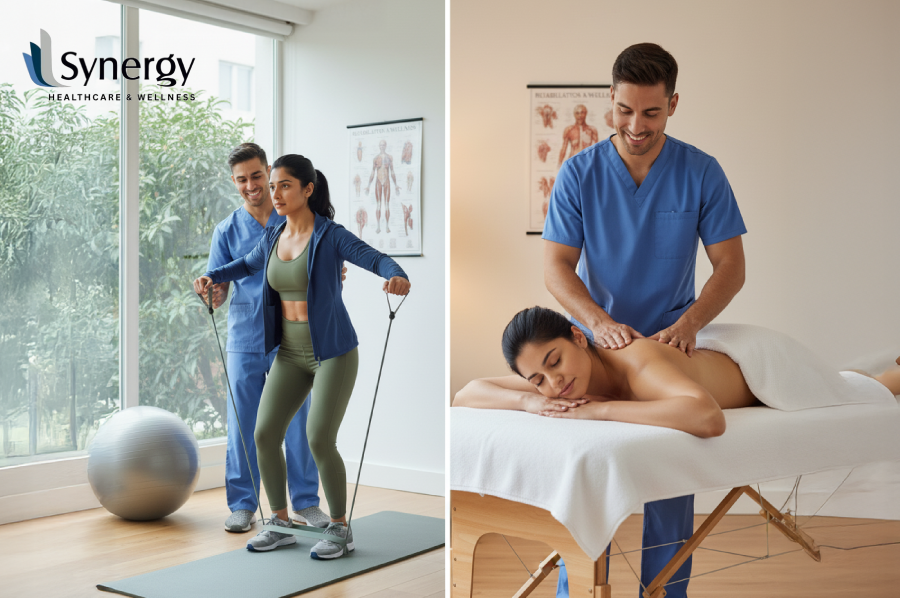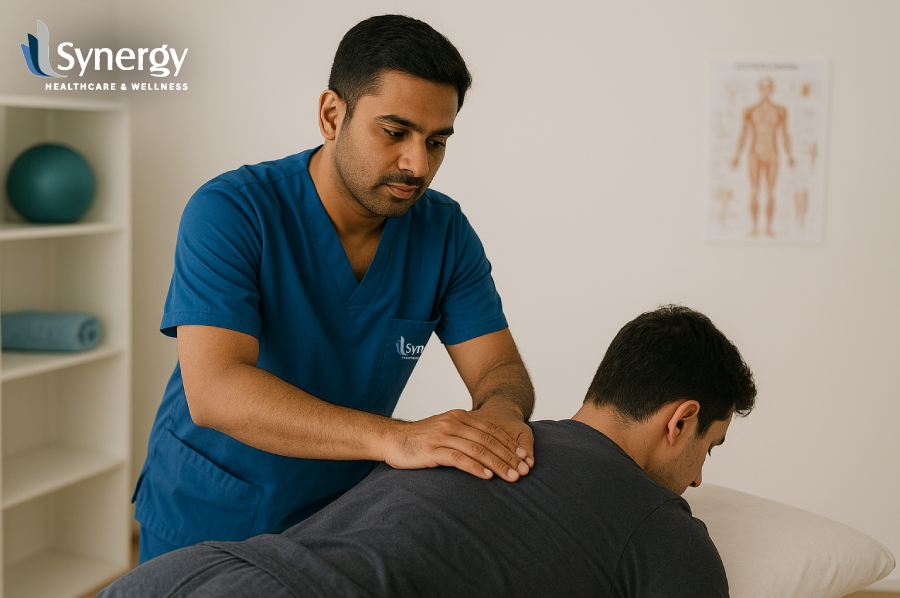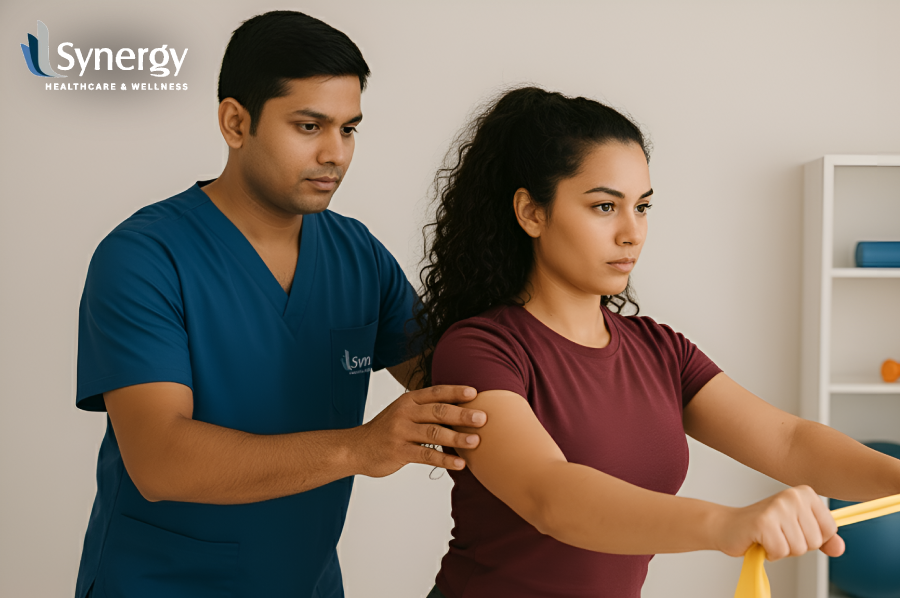Feeling stiff after another long day at your desk? Find out how physiotherapy for office workers can restore balance, ease tension, and keep your spine strong throughout the workday.
Let’s Begin
If you spend most of your workday at a desk, you’ve probably felt that familiar stiffness in your neck or tightness in your back. You’re not alone. Long hours of sitting, staring at screens, and poor posture can quietly wear down the body. What starts as mild discomfort can eventually turn into chronic pain or muscle imbalance.
This blog will help you understand why office work strains the body, how physiotherapy can help, and what simple exercises and habits can keep you moving comfortably throughout the day.
Why Office Work Strains the Back and Neck
1. Staying Still for Too Long
Sitting in one position for hours limits blood flow and tires your muscles. Over time, this leads to stiffness, fatigue, and small injuries that accumulate day after day.
2. Forward Head and Rounded Shoulders
If your head leans forward toward the screen and your shoulders round, you’re putting extra pressure on the spine and neck muscles. This posture is one of the most common causes of upper back and neck tension among office workers.
3. Poor Ergonomic Setup
If your chair, desk, or monitor isn’t adjusted correctly, your body is constantly compensating. Reaching for the mouse, leaning to one side, or working without lumbar support can gradually cause pain and imbalance.
4. Weak Support Muscles
Sitting too much weakens the core and postural stabilisers — the muscles that hold your spine in alignment. Once they lose endurance, the neck and back have to work harder to keep you upright.
How Physiotherapy Makes a Difference
Physiotherapy focuses on restoring movement, correcting posture, and strengthening weak muscles. It isn’t just about treating pain — it’s about teaching your body to move and support itself more efficiently.
Research consistently shows that:
- Strengthening and stretching programmes reduce pain and stiffness.
- Combining ergonomic adjustments with exercise works better than either alone.
- Consistency is key — short, regular sessions are far more effective than occasional workouts.
What to Expect from a Physiotherapy Programme
A physiotherapist will tailor a plan that suits your needs, but most programmes include:
Assessment: They’ll start by checking your posture, mobility, and muscle balance. This helps identify where strain and weakness originate.
Education: You’ll learn how to recognise harmful postures, take effective breaks, and make small adjustments during your workday.
Ergonomic Advice: Simple tweaks to your chair height, desk position, and monitor level can make a big difference. The goal is to reduce strain and support natural alignment.
Targeted Exercises: You might work on:
- Deep neck flexor training to improve head control.
- Scapular and upper back strengthening for better shoulder stability.
- Core activation to support your lower spine.
- Stretching routines for the neck, chest, hips, and back to counter stiffness.
Progress Tracking: Your plan will evolve as you get stronger. Regular check-ins ensure you’re improving safely and steadily.
Easy Desk Exercises You Can Try
Here are a few physiotherapy-approved exercises you can do right at your desk. Move slowly and stay within a comfortable range.
| Exercise | How to Do It | Reps / Frequency |
| Chin Tucks | Sit tall. Gently pull your chin back as if making a double chin. Hold for 5–8 seconds. | 10–15 reps, twice daily |
| Side Neck Stretch | Tilt your head toward one shoulder and hold. | 3–5 reps each side, twice daily |
| Scapular Squeeze | Pull your shoulder blades together and down. Hold for 5 seconds. | 10–15 reps, 2–3 sets |
| Wall Angels | Stand with your back and arms against the wall. Slide arms up and down slowly. | 8–12 reps, once daily |
| Seated Cat–Cow | Alternate between arching and rounding your spine. | 10–15 reps every hour |
| Thoracic Extension | Lean back over the chair’s backrest with your hands behind your head. | 10 reps, 2–3 sets |
| Hip Flexor Stretch | Step one leg back, keep the torso upright, and stretch the front of the hip. | Hold 30 seconds on each side |
Tips:
- Move gently — never force a stretch.
- Breathe normally.
- If pain worsens, stop and reassess your posture or form.
Habits That Protect Your Spine
Physiotherapy goes beyond exercise. Building new habits into your day is what truly prevents pain.
- Take micro-breaks: Stand up or stretch every 30–45 minutes.
- Switch positions: Alternate between sitting and standing if possible.
- Use reminders: Set small cues to check your posture.
- Keep feet flat: Use a footrest if your chair is high.
- Hydrate and move: Drink water and take short walks.
- Rest well: A supportive mattress and pillow allow your spine to recover overnight.
When to See a Physiotherapist
If your pain:
- Lasts more than a few weeks,
- Radiates down your arm or leg,
- Causes numbness or tingling,
…it’s time to get professional help.
A physiotherapist can assess deeper issues, guide your exercises safely, and use manual techniques or other treatments to speed recovery.
What You Can Expect Over Time
With steady effort:
- Pain and stiffness often ease within a few weeks.
- Posture and muscle control improve over months.
- Relapses become less frequent.
- Workdays feel more comfortable and productive.
Consistency matters more than perfection. Even small, regular changes make a lasting difference.
Guided Care for a Stronger, Healthier You
At Synergy, we believe recovery is a journey best guided by expertise and care. Every client begins with a detailed consultation led by senior doctors who assess the root cause of pain or dysfunction. Based on this evaluation, our physiotherapists design a personalised treatment plan that restores movement and reduces discomfort. Once pain is managed, we guide you through a focused rehabilitation phase to rebuild stability and function. For those who wish to continue, we offer advanced strengthening programmes that enhance long-term resilience and performance. Our goal is simple — to help you move better, feel stronger, and return to life with confidence.
Takeaway [Physiotherapy for Office Workers]
Back and neck strain don’t have to be part of office life. With the right exercises, ergonomic setup, and guidance from a physiotherapist, you can work comfortably and protect your spine for the long term. Start with one or two exercises today, take regular breaks, and pay attention to how your body feels. Small actions, repeated often, add up to real results.
FAQs
1. Why do I get neck or back pain even though I’m just sitting all day?
Sitting for long hours tires your postural muscles and limits blood flow. Over time, small strains build up in the spine and supporting muscles, leading to stiffness or pain.
2. Can poor posture really cause long-term problems?
Yes. Slouching or leaning forward repeatedly can weaken key stabilising muscles and place extra pressure on the spine, which may cause chronic discomfort or even disc-related issues.
3. How can physiotherapy help with office-related pain?
Physiotherapists identify the root cause of your discomfort, correct posture, and teach specific exercises to strengthen weak muscles. They also guide ergonomic changes that prevent symptoms from returning.
4. Do I need a referral to see a physiotherapist?
In most cases, no. You can book a consultation directly. However, if your pain involves numbness, tingling, or severe restriction, it’s best to consult a doctor first.
5. How long does it take to see results?
Mild pain often improves within two to four weeks of consistent treatment and home exercises. Lasting changes, especially in posture and strength, typically take a few months.

